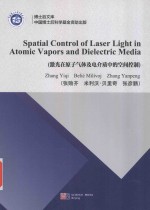
- 作 者:张贻齐(ZHANGYIQI),米利沃·贝里奇(BELICMILIVOJ),张彦鹏(ZHANGYANPENG)著
- 出 版 社:北京:科学出版社
- 出版年份:2016
- ISBN:9787030488725
- 标注页数:206 页
- PDF页数:218 页
请阅读订购服务说明与试读!
订购服务说明
1、本站所有的书默认都是PDF格式,该格式图书只能阅读和打印,不能再次编辑。
2、除分上下册或者多册的情况下,一般PDF页数一定要大于标注页数才建议下单购买。【本资源218 ≥206页】
图书下载及付费说明
1、所有的电子图书为PDF格式,支持电脑、手机、平板等各类电子设备阅读;可以任意拷贝文件到不同的阅读设备里进行阅读。
2、电子图书在提交订单后一般半小时内处理完成,最晚48小时内处理完成。(非工作日购买会延迟)
3、所有的电子图书都是原书直接扫描方式制作而成。
Chapter 1 BASIC THEORY 1
1.1 The paraxial wave equation 1
1.2 Susceptibilities in atomic vapors 3
REFERENCES 8
Chapter 2 SPATIAL LIGHT CONTROL 10
2.1 Photonic topological insulators in atomic ensembles 10
2.1.1 Theoretical model 11
2.1.2 Refractive index change 13
2.1.3 Topology of the photonic band gap structure 14
2.1.4 Photonic Floquet topological insulator 17
2.1.5 Discussion 20
2.1.6 Summary 23
Appendix Ⅰ:Band structure of a honeycomb lattice-the tight-binding method 24
AⅠ.1 Full band structure 24
AⅠ.2 Strained band structure 27
Appendix Ⅱ:Band structure of a honeycomb lattice-the plane-wave expansion method 29
2.2 Talbot effect of multi-wave mixings 31
2.2.1 Theoretical model and analysis 33
2.2.2 Suppression and enhancement conditions 35
2.2.3 Talbot effect of multi-wave mixing signals 37
2.2.4 Summary 42
2.3 Nonlinear Talbot effect from rogue waves 42
2.3.1 Basic rogue wave solutions 43
2.3.2 One-dimensional case 45
2.3.3 Two-dimensional case-linear Talbot effect 47
2.3.4 Two-dimensional case-nonlinear Talbot effect 51
2.3.5 Summary 57
2.4 Beam splitter and combiner based on Bloch oscillations 57
2.4.1 Waveguide array with m≤0 members modulated 59
2.4.2 Beam splitter based on the V-type modulated waveguide array 61
2.4.3 Beam combiner based on the ?-type modulated waveguide array 62
2.4.4 Summary 64
REFERENCES 65
Chapter 3 NONLINEARITY-INDUCED SPATIAL MODULATION 75
3.1 Introduction 75
3.2 Optical vortices induced in atomic vapors 76
3.2.1 Theoretical model 77
3.2.2 Simple vortex and necklace incidence 79
3.2.3 Azimuthon incidence 81
3.2.4 The enhancement region 85
3.2.5 The liquid-like behavior of light and potential experiment 87
3.2.6 Summary 87
3.3 Interactions between incoherent solitons 88
3.3.1 Theoretical model 88
3.3.2 Numerical simulations and discussions 90
3.3.3 Summary 95
3.4 Azimuthons in weakly nonlinear waveguides 95
3.4.1 Theoretical model 95
3.4.2 Rotating localized dipoles 97
3.4.3 Rotating higher order localized modes 105
3.4.4 Summary 106
REFERENCES 107
Chapter 4 SPATIAL CONTROL OF NOVEL LIGHT BEAMS 114
4.1 Introduction 114
4.2 Interactions between Airy beams 114
4.2.1 Theoretical model 115
4.2.2 Interactions of Airy beams 118
4.2.3 Interactions of nonlinear accelerating beams 121
4.2.4 Interactions of different accelerating beams 123
4.2.5 Summary 125
4.3 Airy beams with initial velocity 126
4.3.1 One-dimensional case 126
4.3.2 Two-dimensional case 130
4.3.3 A little discussion 132
4.3.4 Summary 132
4.4 Dual accelerating Airy-Talbot recurrence effect 133
4.4.1 Theoretical model 133
4.4.2 Numerical simulations 134
4.4.3 Superposition of finite-energy Airy beams 137
4.4.4 Summary 138
4.5 Nonparaxial self-accelerating beams 139
4.5.1 Theoretical model 140
4.5.2 Mathieu beams 141
4.5.3 Weber beams 143
4.5.4 Fresnel integrals 145
4.5.5 Summary 146
4.6 Fresnel diffraction patterns as self-accelerating beams 147
4.6.1 One-dimensional case 147
4.6.2 Two-dimensional case 152
4.6.3 Summary 153
4.7 Spatial control of light due to harmonic potential 154
4.7.1 Theoretical model 155
4.7.2 Solutions and numerical simulations 156
4.7.3 Chirped finite energy Airy beams 162
4.7.4 Two-dimensional Airy beams 166
4.7.5 Two-dimensional case-the rotating light 168
4.7.6 Summary 174
4.8 Self-Fourier beams 174
4.8.1 Theoretical model 175
4.8.2 Discussion 177
4.8.3 Analytical solutions 179
4.8.4 Self-Fourier beams 181
4.8.5 Summary 184
4.9 Spatial control in a fractional Schr?dinger equation 185
4.9.1 Theoretical model 186
4.9.2 One-dimensional case 188
4.9.3 Two-dimensional case 191
4.9.4 Summary 192
REFERENCES 193
Chapter 5 CONCLUSION AND OUTLOOK 202
5.1 Summary 202
5.2 Outlook 203
REFERENCES 204
编后记 206
